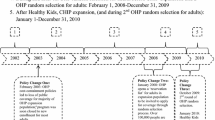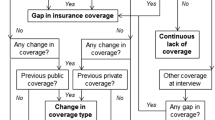Abstract
To identify predictors of coverage continuity for United States children and assess how they have changed in the first 12 years since implementation of the Children’s Health Insurance Program in 1997. Using data from the nationally-representative Medical Expenditure Panel Survey, we used logistic regression to identify predictors of discontinuity in 1998 and 2009 and compared differences between the 2 years. Having parents without continuous coverage was the greatest predictor of a child’s coverage gap in both 1998 and 2009. Compared to children with at least one parent continuously covered, children whose parents did not have continuous coverage had a significantly higher relative risk (RR) of a coverage gap [RR 17.96, 95 % confidence interval (CI) 14.48–22.29 in 1998; RR 12.88, 95 % CI 10.41–15.93 in 2009]. In adjusted models, parental continuous coverage was the only significant predictor of discontinuous coverage for children (with one exception in 2009). The magnitude of the pattern was higher for privately-insured children [adjusted relative risk (aRR) 29.17, 95 % CI 20.99–40.53 in 1998; aRR 25.54, 95 % CI 19.41–33.61 in 2009] than publicly-insured children (aRR 5.72, 95 % CI 4.06–8.06 in 1998; aRR 4.53, 95 % CI 3.40–6.04 in 2009). Parental coverage continuity has a major influence on children’s coverage continuity; this association remained even after public health insurance expansions for children. The Affordable Care Act will increase coverage for many adults; however, ‘churning’ on and off programs due to income fluctuations could result in coverage discontinuities for parents. If parental coverage instability persists, these discontinuities may continue to have a negative impact on children’s coverage stability as well.
Similar content being viewed by others
References
Vistnes, J. P., Zawacki, A., Simon, K., & Taylor, A. (2012). Declines in employer-sponsored insurance coverage between 2000 and 2008: Examining the components of coverage by firm size. Health Services Research, 47(3 Pt 1), 919–938.
Kaiser family foundation and health research and educational trust. (2008). Employer Health Benefits: 2008 annual survey. Kaiser family foundation and health research and educational trust [cited 2009 February 22]. http://ehbs.kff.org/pdf/7790.pdf.
Gould, E. (2010). Employer-sponsored health insurance erosion continues in 2008 and is expected to worsen. International Journal of Health Services, 40(4), 743–776. (Epub 2010/11/10).
Mann, C. (2009). Family coverage: Covering parents along with their children. Washington, DC: Center for Children and Families, Georgetown University Health Policy Institute.
Medicaid.gov. (2012). Children’s Health Insurance Program. Baltimore, MD: Centers for Medicare & Medicaid Services [cited 2013 June 19]. http://www.medicaid.gov/Medicaid-CHIP-Program-Information/By-Topics/Childrens-Health-Insurance-Program-CHIP/Childrens-Health-Insurance-Program-CHIP.html.
Choi, M., Sommers, B. D., & McWilliams, J. M. (2011). Children’s health insurance and access to care during and after the CHIP expansion period. Journal of Health Care for the Poor and Underserved, 22(2), 576–589.
Ryan, J. (2009). The children’s health insurance program (CHIP): The fundamentals. Washington, DC: The George Washington University.
Henry, J. (2009). Kaiser family foundation. Children’s coverage and SCHIP reauthorization [cited 2013 June 19]. http://www.kaiseredu.org/Issue-Modules/Childrens-Coverage-and-SCHIP-Reauthorization/Background-Brief.aspx.
Kaiser Commission on Medicaid and the Uninsured. (2007, January). Health coverage for low-income children [cited 2009 February 20]. http://www.kff.org/uninsured/upload/2144-05.pdf.
Olson, L. M., Tang, S. S., & Newacheck, P. W. (2005). Children in the United States with discontinuous health insurance coverage. New England Journal of Medicine, 353(4), 382–391.
Crocetti, M., Ghazarian, S. R., Myles, D., Ogbuoji, O., & Cheng, T. L. (2012). Characteristics of children eligible for public health insurance but uninsured: Data from the 2007 National Survey of Children’s Health. Maternal and Child Health Journal, 16(Suppl 1), S61–S69. (Epub 2012/03/29).
DeVoe, J. E., Tillotson, C. J., & Wallace, L. S. (2009). Children’s receipt of health care services and family health insurance patterns. Annals of Family Medicine, 7(5), 406–413.
DeVoe, J. E., Graham, A., Krois, L., Smith, J., & Fairbrother, G. L. (2008). “Mind the gap” in children’s health insurance coverage: Does the length of a child’s coverage gap matter? Ambulatory Pediatrics, 8(2), 129–134.
Wisk, L. E., & Witt, W. P. (2012). Predictors of delayed or forgone needed health care for families with children. Pediatrics, 130(6), 1027–1037. (Epub 2012/11/07).
Franks, P., Clancy, C. M., Gold, M. R., & Nutting, P. A. (1993). Health insurance and subjective health status: Data from the 1987 National Medical Expenditure survey. American Journal of Public Health, 83(9), 1295–1299.
Yu, S. M., Bellamy, H. A., Kogan, M. D., Dunbar, J. L., & Schwalberg, R. H. (2002). Factors that influence receipt of recommended preventive pediatric health and dental care. Pediatrics, 110(6), e73.
Newacheck, P. W., Stoddard, J. J., Hughes, D. C., & Pearl, M. (1998). Health insurance and access to primary care for children. New England Journal of Medicine, 338(8), 513–519.
Hadley, J. (2003). Sicker and poorer: The consequences of being uninsured. Medical Care Research and Review, 60(2 Suppl), 3S–75S.
Fairbrother, G., Madhavan, G., Goudie, A., Watring, J., Sebastian, R. A., Ranbom, L., et al. (2011). Reporting on continuity of coverage for children in Medicaid and CHIP: What states can learn from monitoring continuity and duration of coverage. Academic Pediatrics, 11(4), 318–325.
DeVoe, J. E., Tillotson, C. J., & Wallace, L. S. (2011). Insurance coverage gaps among US children with insured parents: Are middle income children more likely to have longer gaps? Maternal and Child Health Journal, 15(3), 342–351.
Yamauchi, M., Carlson, M. J., Wright, B. J., Angier, H., & Devoe, J. E. (2012). Does health insurance continuity among low-income adults impact their children’s insurance coverage? Maternal and Child Health Journal, 17(2), 248–255.
Sommers, B. D. (2006). Insuring children or insuring families: Do parental and sibling coverage lead to improved retention of children in Medicaid and CHIP? Journal of Health Economics, 25(6), 1154–1169.
DeVoe, J. E., Tillotson, C., & Wallace, L. S. (2008). Uninsured children and adolescents with insured parents. JAMA The Journal of the American Medical Association, 300(16), 1904–1913. (Epub 2008/10/23).
DeVoe, J. E., Krois, L., Edlund, T., Smith, J., & Carlson, N. E. (2008). Uninsurance among children whose parents are losing Medicaid coverage: Results from a statewide survey of Oregon families. Health Services Research, 43(1 Pt 2), 401–418. (Epub 2008/01/18).
Cohen, J., Monheit, A., Beauregard, K., et al. (1996–1997). The Medical Expenditure Panel Survey: A national health information resource. Inquiry, 33(4), 373–389.
Agency for Healthcare Research and Quality. (2004). Medical Expenditure Panel Survey. Silver Springs, MD: Agency for healthcare research and quality [cited 2013 June 19]. http://www.meps.ahrq.gov/mepsweb/.
Weinick, R. M., Zuvekas, S. H., & Drilea, S. K. (1996). Access to health care: Source and barriers. MEPS research findings no. 3. AHCPR Pub. No. 98-0001. Rockville, MD: Agency for Healthcare Research and Quality.
Cohen, S. (1997). Sample design of the 1996 Medical Expenditure Panel Survey household component. MEPS methodology report no. 2. Pub. No. 97-0027. Rockville, MD: Agency for Healthcare Research and Quality.
Cohen, J. W., Cohen, S. B., & Banthin, J. S. (2009). The medical expenditure panel survey: A national information resource to support healthcare cost research and inform policy and practice. Medical Care, 47(7 Suppl 1), S44–S50.
Agency for Healthcare Research and Quality. (2008). MEPS HC-036: 1996–2006 pooled estimation file [cited 2012 February 20]. http://meps.ahrq.gov/mepsweb/data_stats/download_data_files.jsp.
Hill, H. D., & Shaefer, H. L. (2011). Covered today, sick tomorrow? Trends and correlates of children’s health insurance instability. Medical Care Research and Review, 68(5), 523–536.
McNutt, L., Wu, C., Xue, X., & Hafner, J. (2003). Estimating the relative risk in cohort studies and clinical trials of common outcomes. American Journal of Epidemiology, 157, 940–943.
111th Congress. (2010). Compilation of Patient Protection And Affordable Care Act [cited 2011 December 16]. http://docs.house.gov/energycommerce/ppacacon.pdf.
Medicaid.gov. (2012). Children's Health Insurance Program. Baltimore, MD: Centers for Medicare & Medicaid Services [cited 2012 March 6]. http://www.medicaid.gov/Medicaid-CHIP-Program-Information/By-Topics/Childrens-Health-Insurance-Program-CHIP/Childrens-Health-Insurance-Program-CHIP.html.
Henry, J. (2012, August). Kaiser family foundation. Implementing the ACA’s medicaid-related health reform provisions after the Supreme Court’s decision. Report no.: 8348.
Kenney, G., Dubay, L., Zuckerman, S., & Huntress, M. (2012, June 29). Making the medicaid expansion an ACA option: How many low-income Americans could remain uninsured.
McDonough, J. E. (2012). The road ahead for the Affordable Care Act. New England Journal of Medicine, 367(3), 199–201.
Sommers, B. D., & Rosenbaum, S. (2011). Issues in health reform: How changes in eligibility may move millions back and forth between Medicaid and insurance exchanges. Health Affairs, 30(2), 228–236.
Klein, K., Glied, S., & Ferry, D. (2005). Entrances and exits: Health insurance churning, 1998–2000. Issue brief (Commonwealth Fund).
Racine, A. D., Long, T. F., Helm, M. E., Hudak, M., Shenkin, B. N., Snider, I. G., et al. (2014). Children’s health insurance program (CHIP): Accomplishments, challenges, and policy recommendations. Pediatrics, 133(3), e784–e793.
Fiscella, K. (2011). Health care reform and equity: Promise, pitfalls, and prescriptions. Annals of Family Medicine, 9(1), 78–84.
Devoe, J. E. (2013). Being uninsured is bad for your health: Can medical homes play a role in treating the uninsurance ailment? The Annals of Family Medicine, 11(5), 473–476. (Epub 2013/09/11).
DeVoe, J., Angier, H., Likumahuwa, S., Hall, J., Nelson, C., Dickerson, K., et al. (2014). Use of qualitative methods and user-centered design to develop customized health information technology tools within federally qualified health centers to keep children insured. Journal of Ambulatory Care Management, 37(2), 148–154.
U.S. Department of Health and Human Services. (1998). Annual update of the HHS poverty guidelines. Federal Register, 63(36), 9235–9238.
U.S. Department of Health and Human Services. (2009). Annual update of the HHS poverty guidelines. Federal Register, 74(14), 4199–4201.
Acknowledgments
This study was financially supported by the Agency for Healthcare Research and Quality (AHRQ) (1 R01 HS018569), the Patient-Centered Outcomes Research Institute (PCORI), and the Oregon Health & Science University Department of Family Medicine. The authors are grateful for editing and publication assistance from Ms. LeNeva Spires, Publications Manager, Department of Family Medicine, Oregon Health & Science University, Portland, Oregon, USA.
Author information
Authors and Affiliations
Corresponding author
Rights and permissions
About this article
Cite this article
DeVoe, J.E., Tillotson, C.J., Angier, H. et al. Predictors of Children’s Health Insurance Coverage Discontinuity in 1998 Versus 2009: Parental Coverage Continuity Plays a Major Role. Matern Child Health J 19, 889–896 (2015). https://doi.org/10.1007/s10995-014-1590-0
Published:
Issue Date:
DOI: https://doi.org/10.1007/s10995-014-1590-0




